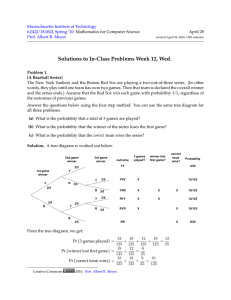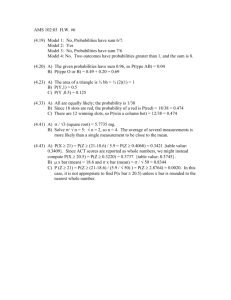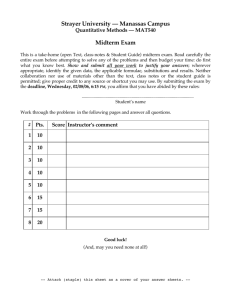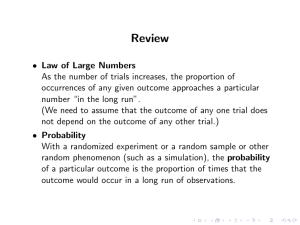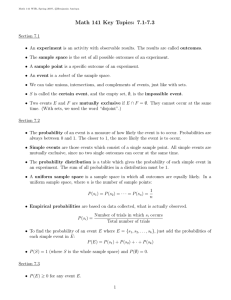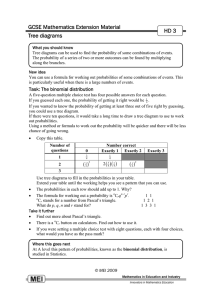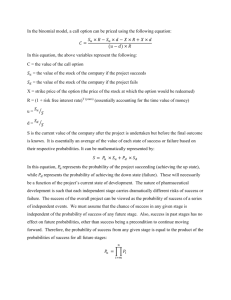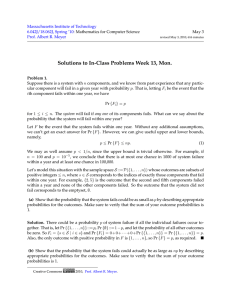In-Class
advertisement
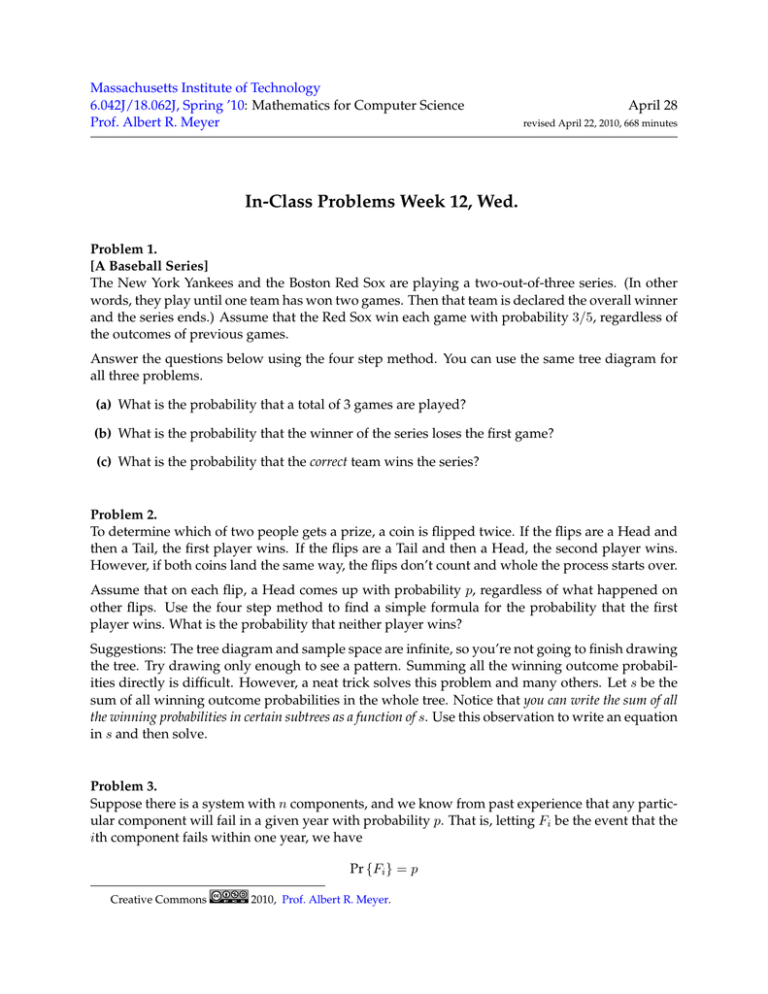
Massachusetts Institute of Technology
6.042J/18.062J, Spring ’10: Mathematics for Computer Science
Prof. Albert R. Meyer
April 28
revised April 22, 2010, 668 minutes
In-Class Problems Week 12, Wed.
Problem 1.
[A Baseball Series]
The New York Yankees and the Boston Red Sox are playing a two-out-of-three series. (In other
words, they play until one team has won two games. Then that team is declared the overall winner
and the series ends.) Assume that the Red Sox win each game with probability 3/5, regardless of
the outcomes of previous games.
Answer the questions below using the four step method. You can use the same tree diagram for
all three problems.
(a) What is the probability that a total of 3 games are played?
(b) What is the probability that the winner of the series loses the first game?
(c) What is the probability that the correct team wins the series?
Problem 2.
To determine which of two people gets a prize, a coin is flipped twice. If the flips are a Head and
then a Tail, the first player wins. If the flips are a Tail and then a Head, the second player wins.
However, if both coins land the same way, the flips don’t count and whole the process starts over.
Assume that on each flip, a Head comes up with probability p, regardless of what happened on
other flips. Use the four step method to find a simple formula for the probability that the first
player wins. What is the probability that neither player wins?
Suggestions: The tree diagram and sample space are infinite, so you’re not going to finish drawing
the tree. Try drawing only enough to see a pattern. Summing all the winning outcome probabil­
ities directly is difficult. However, a neat trick solves this problem and many others. Let s be the
sum of all winning outcome probabilities in the whole tree. Notice that you can write the sum of all
the winning probabilities in certain subtrees as a function of s. Use this observation to write an equation
in s and then solve.
Problem 3.
Suppose there is a system with n components, and we know from past experience that any partic­
ular component will fail in a given year with probability p. That is, letting Fi be the event that the
ith component fails within one year, we have
Pr {Fi } = p
Creative Commons
2010, Prof. Albert R. Meyer.
2
In-Class Problems Week 12, Wed.
for 1 ≤ i ≤ n. The system will fail if any one of its components fails. What can we say about the
probability that the system will fail within one year?
Let F be the event that the system fails within one year. Without any additional assumptions,
we can’t get an exact answer for Pr {F }. However, we can give useful upper and lower bounds,
namely,
p ≤ Pr {F } ≤ np.
(1)
We may as well assume p < 1/n, since the upper bound is trivial otherwise. For example, if
n = 100 and p = 10−5 , we conclude that there is at most one chance in 1000 of system failure
within a year and at least one chance in 100,000.
Let’s model this situation with the sample space S ::=P({1, . . . , n}) whose outcomes are subsets of
positive integers ≤ n, where s ∈ S corresponds to the indices of exactly those components that fail
within one year. For example, {2, 5} is the outcome that the second and fifth components failed
within a year and none of the other components failed. So the outcome that the system did not
fail corresponds to the emptyset, ∅.
(a) Show that the probability that the system fails could be as small as p by describing appropriate
probabilities for the outcomes. Make sure to verify that the sum of your outcome probabilities is
1.
(b) Show that the probability that the system fails could actually be as large as np by describing
appropriate probabilities for the outcomes. Make sure to verify that the sum of your outcome
probabilities is 1.
(c) Prove inequality (1). You may assume the Union Bound in the Appendix.
Problem 4.
Here are some handy rules for reasoning about probabilities that all follow directly from the Dis­
joint Sum Rule in the Appendix. Prove them.
Pr {A − B} = Pr {A} − Pr {A ∩ B}
� �
Pr A = 1 − Pr {A}
Pr {A ∪ B} = Pr {A} + Pr {B} − Pr {A ∩ B}
Pr {A ∪ B} ≤ Pr {A} + Pr {B} .
If A ⊆ B, then Pr {A} ≤ Pr {B} .
(Difference Rule)
(Complement Rule)
(Inclusion-Exclusion)
(2-event Union Bound)
(Monotonicity)
In-Class Problems Week 12, Wed.
3
Appendix
The Four Step Method
This is a good approach to questions of the form, “What is the probability that ——-?” Intuition
can be misleading, but this formal approach gives the right answer every time.
1. Find the sample space. (Use a tree diagram.)
2. Define events of interest. (Mark leaves corresponding to these events.)
3. Determine outcome probabilities:
(a) Assign edge probabilities.
(b) Compute outcome probabilities. (Multiply along root-to-leaf paths.)
4. Compute event probabilities. (Sum the probabilities of all outcomes in the event.)
Probability Spaces
A countable sample space, S, is a nonempty countable set. An element w ∈ S is called an outcome.
A subset of S is called an event.
A probability space consists of a sample space, S, and a function Pr {} : S → [0, 1], called the
probability function, such that
�
Pr {w} = 1.
w∈S
For any event, E ⊆ S, the probability of E is defined to be the sum of the probabilities of the
outcomes in E:
�
Pr {E} ::=
Pr {w} .
w∈E
Sum Rule & Union Bound
Let E0 , E1 , . . . be a (possibly infinite) sequence of events. These events are said to be pairwise
disjoint if Ei ∩ Ej = ∅ whenever i =
� j.
If these events are pairwise disjoint, then
⎧
⎫
⎨ ⎬ �
Pr
En =
Pr {En } .
⎩
⎭
n≥0
(Disjoint Sum Rule)
n≥0
Even if they are not pairwise disjoint,
⎧
⎫
⎨ ⎬ �
Pr
En ≤
Pr {En } .
⎩
⎭
n≥0
i≥n
(Union Bound)
MIT OpenCourseWare
http://ocw.mit.edu
6.042J / 18.062J Mathematics for Computer Science
Spring 2010
For information about citing these materials or our Terms of Use, visit: http://ocw.mit.edu/terms.

